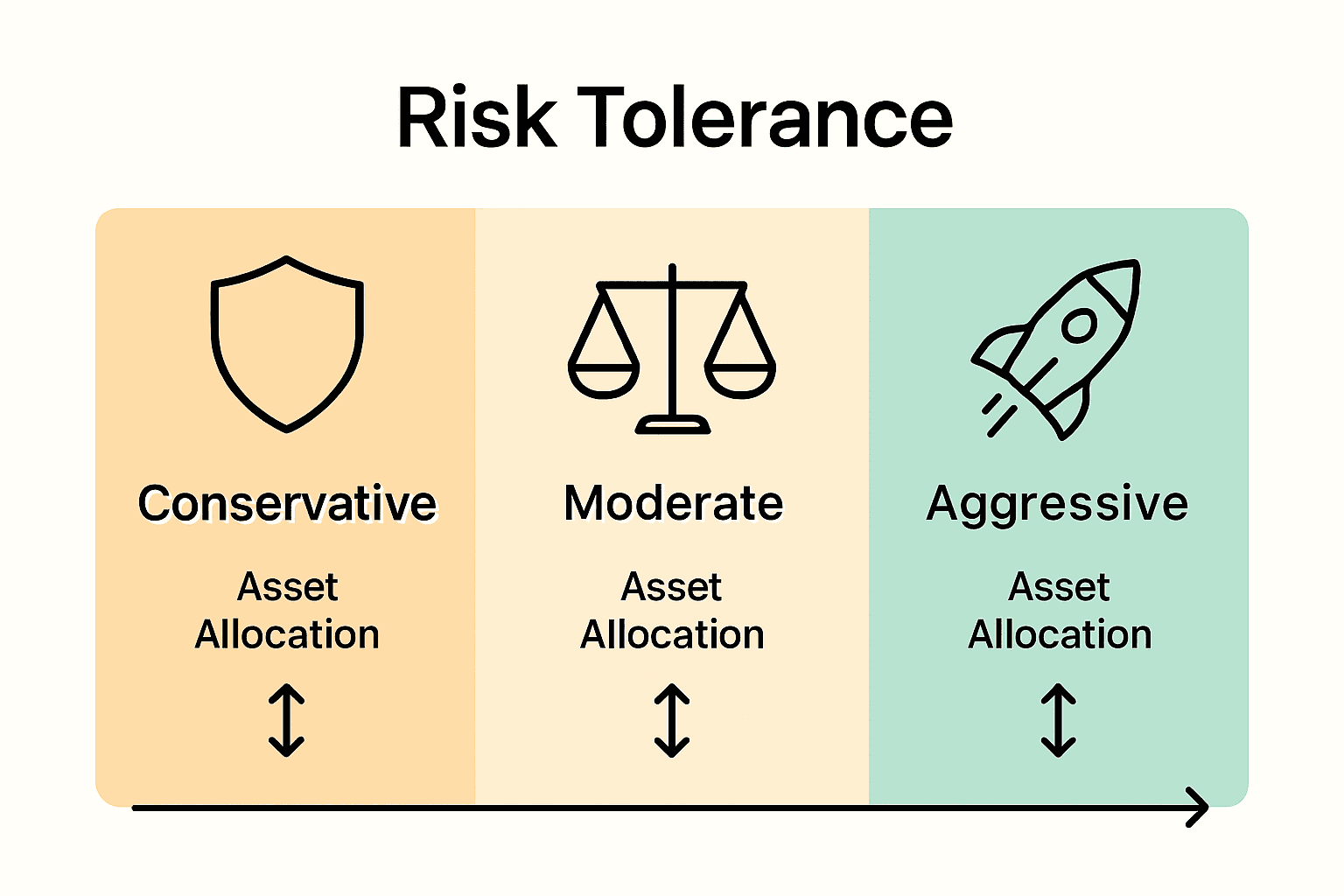Nearly 60 percent of investors admit to making impulsive decisions when markets get turbulent. Feeling confident with your investing strategy comes down to understanding your own comfort with risk and uncertainty. Risk tolerance shapes every financial move you make, from choosing stocks to staying calm during market dips. Learning how to define and measure it gives you the tools to build a portfolio that fits both your wallet and your peace of mind.
Table of Contents
- Defining Risk Tolerance In Investing
- Types Of Risk Tolerance Explained
- How To Assess Your Risk Profile
- Factors Influencing Investor Risk Appetite
- Impact On Portfolio Strategy And Performance
- Common Mistakes And How To Avoid Them
Key Takeaways
| Risk Tolerance Factor | Details |
|---|---|
| Understanding Risk Tolerance | Risk tolerance is the personal comfort level with investment volatility, influenced by demographics, wealth, and experiences. |
| Types of Risk Tolerance | Investors fall into three categories: conservative, moderate, and aggressive, each with different approaches to risk and potential returns. |
| Assessing Risk Profile | Regularly assess both financial and psychological factors to maintain alignment between personal comfort and investment strategies. |
| Avoiding Common Mistakes | Stay aware of behavioral biases, such as overestimating risk tolerance and making emotional decisions, to enhance investment outcomes. |
Defining Risk Tolerance in Investing
Risk tolerance is the personal comfort level an investor has with potential financial uncertainty and potential losses in their investment strategy. According to revistaespacios, risk tolerance reflects the degree of psychological comfort an individual has with investment volatility and potential financial downturns.
At its core, risk tolerance represents an investor’s capacity to withstand market fluctuations without experiencing significant emotional stress or making impulsive financial decisions. As research from iosrjournals indicates, this tolerance is not uniform but varies dramatically based on multiple personal factors such as:
- Demographics
- Personal wealth
- Educational background
- Previous investment experiences
- Overall financial stability
Understanding your personal risk tolerance isn’t just about numbers – it’s about matching your investment strategy with your emotional and financial capacity. Investors with high risk tolerance might feel comfortable with aggressive stock portfolios that have higher potential returns but also greater volatility. Conversely, those with lower risk tolerance might prefer more stable investments like bonds or certificates of deposit that offer more predictable, albeit potentially lower, returns.
To help you better understand your investment approach, we offer a tutorial on building an investment portfolio that can provide deeper insights into aligning your risk tolerance with your financial goals.
Types of Risk Tolerance Explained
Investors typically fall into three primary risk tolerance categories that help define their approach to financial decision-making: conservative, moderate, and aggressive. These classifications aren’t rigid boxes but rather flexible frameworks that help individuals understand their comfort level with investment uncertainty.
Conservative Risk Tolerance
- Prioritizes capital preservation over high returns
- Seeks minimal investment volatility
- Typically prefers low-risk investments like:
- Government bonds
- Certificates of deposit
- High-yield savings accounts
- Ideal for investors nearing retirement or with limited financial flexibility
Moderate Risk Tolerance
- Balances potential growth with measured risk
- Seeks a mix of stable and growth-oriented investments
- Typically allocates portfolio across:
- Bonds (50-60%)
- Stocks (30-40%)
- Alternative investments (5-10%)
- Suitable for investors with medium-term financial goals
Aggressive Risk Tolerance
- Accepts higher potential losses for greater return potential
- Focuses on high-growth investment opportunities
- Typically includes:
- Growth stocks
- Emerging market investments
- Venture capital
- Technology sector investments

For a deeper understanding of managing different investment approaches, check out our guide on financial risk management that can help you navigate these nuanced investment strategies.
How to Assess Your Risk Profile
Assessing your personal risk profile is a critical step in developing a successful investment strategy. According to research from arxiv, understanding your risk preferences can be effectively accomplished through analyzing your existing investment portfolio and applying sophisticated evaluation techniques.
The process of determining your risk profile involves several key components that provide insights into your financial comfort zone:
Personal Financial Assessment
- Current income level
- Age and years until retirement
- Total financial assets
- Existing debt obligations
- Emergency fund status
Psychological Risk Tolerance Evaluation
- Comfort with market volatility
- Emotional reaction to potential losses
- Investment goal timeframe
- Previous investment experiences
- Personal financial goals
Research from arxiv suggests that risk profiles are not static but can vary significantly under different market conditions. This means your risk tolerance isn’t a one-time assessment but a dynamic characteristic that may shift with personal circumstances and broader economic trends.

To gain deeper insights into constructing an investment approach aligned with your risk profile, explore our 7 safe investment options that can help you develop a balanced and personalized investment strategy.
Factors Influencing Investor Risk Appetite
Investor risk appetite is a complex interplay of personal, psychological, and financial factors that shape an individual’s approach to investment decisions. According to research from iosrjournals, several demographic characteristics play a crucial role in determining an investor’s willingness to take financial risks.
Key Demographic Influences on Risk Appetite:
- Age: Younger investors typically demonstrate higher risk tolerance
- Education Level: Higher educational attainment correlates with more sophisticated risk assessment
- Income and Wealth: More financial resources often enable greater risk-taking
- Gender: Research suggests variations in risk perception between genders
- Professional Background: Career experience impacts investment confidence
Psychological factors are equally significant in shaping risk appetite. As revistaespacios highlights, an individual’s comfort with volatility and potential losses dramatically influences their investment approach. This psychological dimension goes beyond raw numbers, encompassing emotional resilience, past investment experiences, and personal financial goals.
Personal risk appetite isn’t static – it evolves with life circumstances, market conditions, and individual growth. Understanding these nuanced influences can help investors make more informed decisions aligned with their financial objectives.
To gain deeper insights into navigating the psychological aspects of investing, explore our guide on the psychology of investing that can help you understand the complex emotional dynamics behind financial decision-making.
Impact on Portfolio Strategy and Performance
Risk tolerance is the fundamental compass that guides investment decision-making, directly influencing portfolio construction and potential financial outcomes. According to Modern Portfolio Theory, an investor’s risk tolerance critically determines how assets are balanced to optimize expected returns while maintaining an acceptable risk level.
Portfolio Composition Strategies Based on Risk Tolerance:
-
Conservative Risk Profile:
- Higher allocation to bonds and fixed-income securities
- Minimal exposure to volatile markets
- Prioritizes capital preservation
-
Moderate Risk Profile:
- Balanced mix of stocks and bonds
- Diversified investment across multiple sectors
- Seeks steady, moderate growth
-
Aggressive Risk Profile:
- Higher percentage of stocks and growth-oriented investments
- Greater allocation to emerging markets
- Accepts higher potential volatility for increased returns
Research from arxiv demonstrates that variations in risk preferences lead to significantly different investment utilities and long-term portfolio outcomes. This means your risk tolerance isn’t just a theoretical concept, but a practical framework that directly impacts financial performance.
To help you develop a nuanced investment approach aligned with your risk profile, explore our comprehensive asset allocation strategies guide that can provide deeper insights into strategic portfolio management.
Common Mistakes and How to Avoid Them
Investors frequently encounter psychological pitfalls that can significantly derail their financial strategies. According to research from arxiv, loss aversion represents one of the most pervasive behavioral mistakes, where investors irrationally hold onto losing investments to avoid acknowledging financial losses.
Top Risk Tolerance Mistakes to Avoid:
-
Overestimating Risk Tolerance
- Taking excessive risks beyond personal comfort zone
- Investing without understanding true emotional capacity
- Potential for panic selling during market volatility
-
Emotional Decision Making
- Reacting impulsively to market fluctuations
- Making investment choices based on fear or excitement
- Abandoning long-term strategies during short-term challenges
-
Misaligning Investment Strategy
- Choosing investments inconsistent with personal risk profile
- Neglecting portfolio diversification
- Failing to periodically reassess risk tolerance
As Wikipedia highlights, overestimating one’s risk tolerance can lead to catastrophic investment decisions, potentially triggering panic selling during market downturns. Understanding and accurately assessing your genuine risk comfort level is crucial for maintaining a stable, successful investment approach.
To develop a more strategic approach to managing investment risks, consider exploring our tutorial on investing during market volatility, which can provide additional insights into navigating complex financial landscapes.
Find Your True Risk Comfort and Build a Smarter Portfolio Today
Understanding your personal risk tolerance can feel overwhelming, especially when investment decisions come with uncertainty and emotional stress. This guide showed how critical it is to align your portfolio with your real comfort level to avoid costly mistakes like overestimating your risk appetite or reacting impulsively to market swings. You may worry about how to balance growth and safety while managing your emotional reactions to market volatility.
That is where expert guidance makes all the difference. Explore practical tools and personalized strategies at finblog.com to better assess your risk profile. Dive into our resources such as the tutorial on building an investment portfolio and the guide on financial risk management designed to help you make confident investment decisions aligned with your goals and emotions. Start taking control of your financial future now. Visit finblog.com to get started with expert insights that can turn investment uncertainty into a clear path forward.
Frequently Asked Questions
What is risk tolerance in investing?
Risk tolerance is the degree of psychological comfort an investor has with potential financial uncertainty and losses. It reflects how much market volatility an individual can endure without making impulsive financial decisions.
How can I assess my risk profile for investing?
To assess your risk profile, consider factors such as your current financial situation, age, income level, emergency fund status, comfort with market volatility, and past investment experiences. These elements will help you determine your comfort level with risk.
What are the different types of risk tolerance?
Risk tolerance generally falls into three categories: conservative, moderate, and aggressive. Conservative investors prioritize capital preservation, moderate investors seek a balance of risk and growth, while aggressive investors are willing to accept higher risks for potentially greater returns.
How does risk tolerance impact my investment strategy?
Your risk tolerance directly influences your portfolio composition. It determines the balance between stable investments like bonds and higher-risk opportunities such as growth stocks, impacting your potential returns and overall investment strategy.










